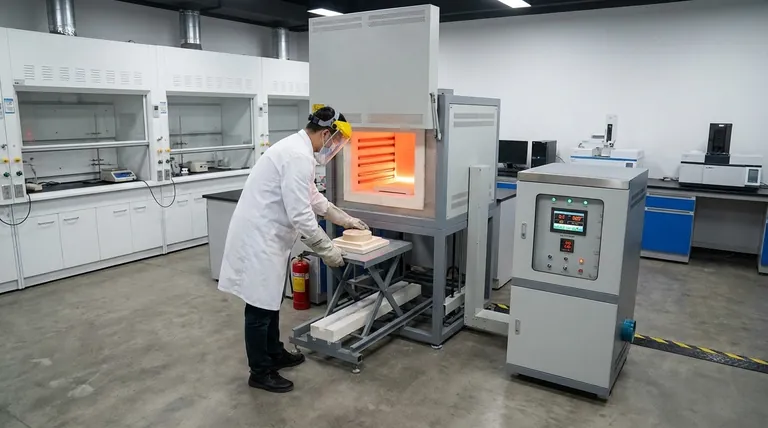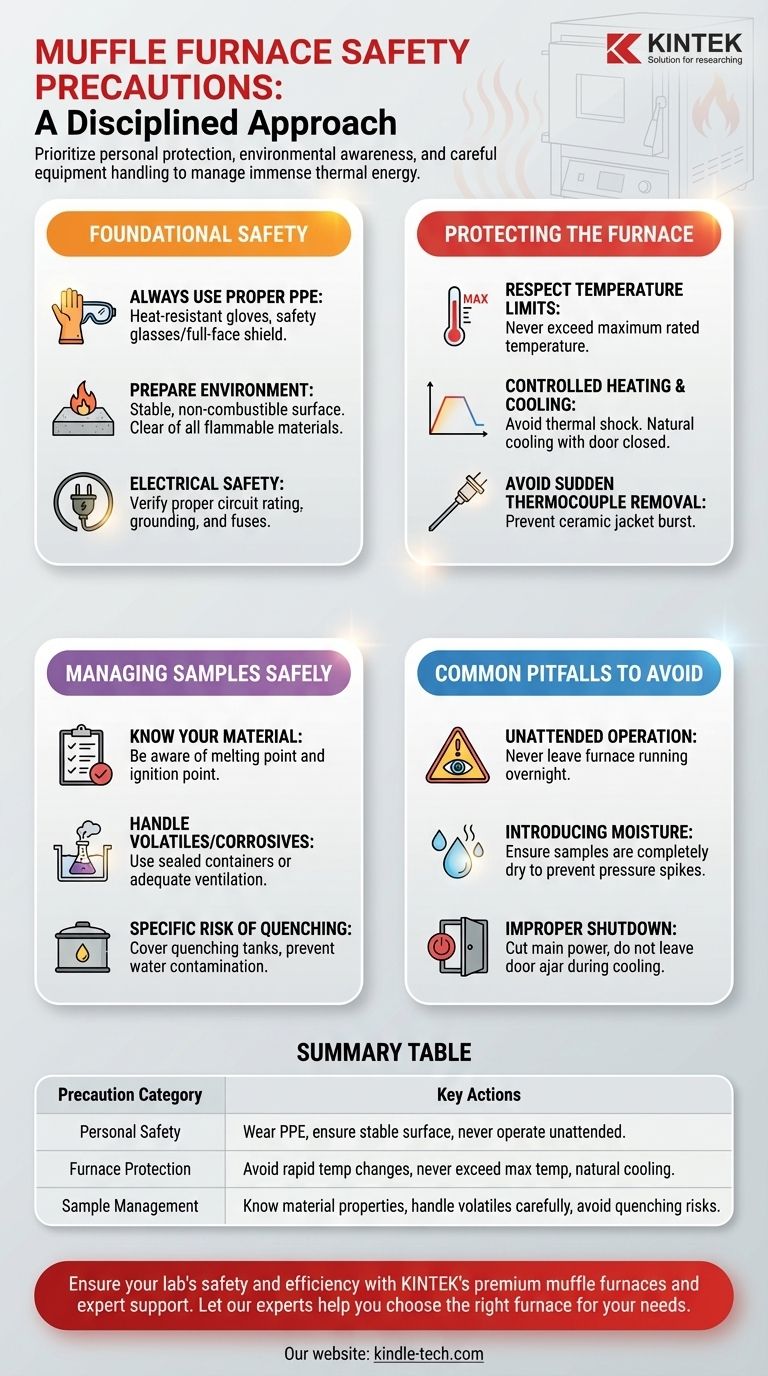At its core, operating a muffle furnace safely requires a disciplined approach that prioritizes personal protection, environmental awareness, and careful equipment handling. The most critical precautions involve always wearing appropriate personal protective equipment (PPE) like heat-resistant gloves and safety goggles, ensuring the furnace is on a stable, non-combustible surface, and never leaving the machine unattended during operation.
Safe furnace operation is not merely a checklist of rules, but a fundamental understanding of the immense thermal energy involved. Your goal is to manage this energy to protect yourself, the integrity of your sample, and the longevity of the instrument itself.

Foundational Safety: Protecting Yourself and Your Workspace
Before you even turn the furnace on, you must establish a safe environment. The extreme temperatures generated by the furnace make this the most critical phase of operation.
Always Use Proper PPE
Your first line of defense is personal protective equipment. The heat radiated from the furnace, even when closed, can be intense.
Always wear heat-resistant gloves rated for the temperatures you are working with. You must also wear safety glasses or a full-face shield to protect against thermal radiation and potential projectiles in the rare case of a sample failure.
Prepare the Operating Environment
The furnace's location is a key safety factor. It must be placed on a stable, level, and non-combustible surface, such as a concrete platform.
Ensure the area is clear of all flammable or explosive materials. This includes liquids, papers, and even airborne dust. The furnace's outer casing, or jacket, becomes very hot and can easily ignite nearby items.
Ensure Proper Electrical Safety
Muffle furnaces are high-power devices. Verify that the furnace is connected to a properly rated circuit with the correct plugs, sockets, and fuses. Crucially, the unit must be grounded to prevent electrical shock.
Protecting the Furnace: Operational Best Practices
Preventing damage to the furnace is essential for both safety and reliable results. Most furnace failures are caused by improper operational procedures, not manufacturing defects.
Respect Temperature Limits
Never exceed the maximum rated temperature of the furnace. Doing so can cause permanent damage to the heating elements and refractory insulation. Even operating at the maximum rated temperature for extended periods will shorten the instrument's lifespan.
The Critical Role of Controlled Heating and Cooling
Thermal shock is the enemy of a muffle furnace. Avoid rapid temperature changes. When starting the furnace, especially after a long period of disuse, run a bake-out cycle at a low temperature to slowly drive off any absorbed moisture, which can crack the refractory lining.
Never open the furnace door when the internal temperature is high (e.g., above 600°C unless specified by the manufacturer). The rush of cool air can cause the ceramic insulation to crack. After your process is complete, turn off the power and allow the furnace to cool naturally with the door closed.
Avoid Sudden Thermocouple Removal
The thermocouple is the furnace's sensor. Do not pull the thermocouple out suddenly when the furnace is at high temperature. The rapid temperature change can cause the protective ceramic jacket to burst.
Managing Your Samples Safely
What you put inside the furnace is just as important as how you operate it. An inappropriate sample can release harmful gases, damage the furnace, or create a fire hazard.
Know Your Material's Properties
Before heating any substance, you must know its properties. Specifically, be aware of its melting point and ignition point to ensure it can withstand the target temperature without catching fire or reacting unexpectedly.
Handle Volatile or Corrosive Substances
Never pour liquids directly into the furnace chamber. When heating materials that contain fats, oils, or other volatile compounds, be aware that they can release corrosive gases.
These gases can attack and destroy the furnace's heating elements. If you must heat such materials, they should be placed in a sealed container or the furnace must have adequate ventilation to exhaust the fumes safely.
The Specific Risk of Quenching
If your process involves quenching hot materials in oil, exercise extreme caution. The oil may catch fire when the hot sample is introduced.
Ensure quenching tanks are covered when not in use and that the quenching oil is never contaminated with water. Water contamination can cause violent splattering of hot oil.
Common Pitfalls to Avoid
Even experienced operators can make mistakes. Being aware of these common pitfalls is a key part of a comprehensive safety mindset.
Unattended Operation
A muffle furnace should never be left to operate unattended, especially overnight. If the temperature controller fails, the furnace can overheat, creating a severe fire hazard. Constant monitoring is necessary to prevent accidents.
Introducing Moisture
Placing wet or damp samples into a hot furnace is extremely hazardous. The water will rapidly turn to steam, creating a pressure spike that can damage the sample, the furnace, and potentially cause the door to burst open. Always ensure samples are completely dry.
Improper Shutdown
After use, always ensure the main power is cut off. Leaving the door ajar on a cooling furnace may seem like it speeds up the process, but it introduces thermal stress and allows ambient moisture to be absorbed into the warm refractory, which can cause damage on the next heat cycle.
Making the Right Choice for Your Goal
Your specific procedure will dictate which precautions are most critical, but all are interconnected.
- If your primary focus is personal safety: Always wear appropriate PPE and never open a hot furnace door. Keep the area clear of all flammables.
- If your primary focus is equipment longevity: Adhere to gradual heating/cooling cycles, never exceed the max temperature, and keep the furnace chamber dry and clean.
- If your primary focus is sample integrity: Ensure your samples are dry, use proper containers for volatile materials, and understand the thermal properties of everything you place inside.
Ultimately, disciplined and knowledgeable operation is the only way to ensure safety and achieve reliable results with a muffle furnace.
Summary Table:
| Precaution Category | Key Actions |
|---|---|
| Personal Safety | Wear heat-resistant gloves & safety goggles; ensure stable, non-combustible surface; never operate unattended. |
| Furnace Protection | Avoid rapid temperature changes; never exceed max temperature; allow natural cooling; prevent moisture ingress. |
| Sample Management | Know material properties (melting/ignition points); handle volatile/corrosive substances carefully; avoid quenching risks. |
Ensure your lab's safety and efficiency with KINTEK's premium muffle furnaces and expert support.
KINTEK specializes in durable, high-performance lab equipment designed with safety in mind. Our muffle furnaces feature robust construction and precise temperature control to support your demanding applications.
Let our experts help you choose the right furnace for your needs and provide guidance on safe operation.
Contact us today to discuss your laboratory requirements and discover how KINTEK can enhance your thermal processing workflows.
Visual Guide

Related Products
- Laboratory Muffle Oven Furnace Bottom Lifting Muffle Furnace
- 1800℃ Muffle Oven Furnace for Laboratory
- 1700℃ Muffle Oven Furnace for Laboratory
- 1400℃ Muffle Oven Furnace for Laboratory
- 1400℃ Laboratory Quartz Tube Furnace with Alumina Tube Tubular Furnace
People Also Ask
- Do different liquids melt at different rates? Unlock the Science of Melting Points and Material Properties
- Does melting point ever change? Unlock the Secrets of Pressure and Purity
- What is the temperature limit on a muffle furnace? A Guide to Selecting the Right Model
- What hazard is involved when using a furnace? Protect Your Home from the Silent Killer
- What affects the melting point of a substance? Uncover the Key Factors & Forces



















